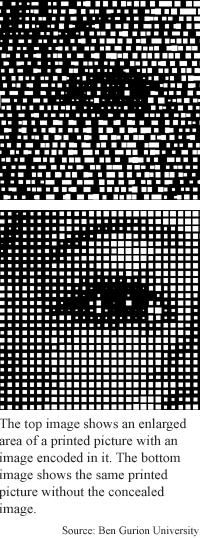
Printed
pictures hide images
By
Chhavi Sachdev,
Technology Research NewsIt's not hard to hide information in a digital image, but when the image is printed out, the hidden information is usually left behind on the computer.
A pair of researchers from Ben Gurion University in Israel have come up with a way to hide an image within a printed picture, allowing hard copies of an image to retain hidden information.
The scheme hides one half-tone picture in another so that scanners like those in supermarkets can unlock and view the information. The technique could be used to hide barcodes in product labels and fingerprints in ID pictures.
The researchers’ system puts together two data files for two images, “one that we want to print as an observable picture and the other that we want to conceal within the observable picture," said Joseph Rosen, associate professor of electrical and computer engineering at Ben Gurion University.
The second, hidden image is coded into the first picture. The researchers scramble the mathematical representation of the hidden image with a mathematical key. Once an image is encoded, "only an authorized person who has the key... can reveal the hidden image,” Rosen said.
The composite image can be printed on any printer; the print can then be read by a conventional optical scanner and processed by a PC to access the hidden image, said Rosen.
The method works because almost every printed picture is a halftone image, meaning it is actually a series of discrete dots. But because these dots are too small for the naked eye to see, a black and white picture appears many shades of gray. “A gray-tone printed picture is a collection of many white-only dots on a black background. The size of the dots, or their density, defines the level of the gray-tone that we see,” said Rosen.
The hidden image is encoded in the position of the visible image's dots. Each dot can be shifted without significantly changing the visible image, and the altered positions can be mapped as a mathematical code.
Although the researchers have only hidden gray-tone pictures, the same method could be used for color, he said. A color picture is “still a composite of dots but this time there are 3 color dots -- red, green and blue,” he said.
While the visible image looks slightly fuzzy, there is no way for the eye to discern the hidden image. The deciphering depends on the key. “The correlation is an operation of scrambling the key... with one image in order to get the other image,” he said.
This system is optical and different from digital watermarking, which hides information within the numbers that make up the digital image, said Rosen. “Instead of having digits to play with, we have binary dots that we manipulate,” Rosen said.
Printed copies of the researchers' pictures still contain the hidden file, but printouts of digital files that contain watermarks do not retain those watermarks. "When you print out a [digital] file the numbers become gray levels and the hidden information gets lost,” he said.
Like a hologram, the hidden image is concealed in a global manner, said Rosen. “Every part of the [visible image] contains information on the entire hidden image, such that if you cover or destroy part of the concealogram you can still recover the entire hidden image from the rest,” he said. The hidden image can be elicited even when 55 percent of the halftone picture is damaged or missing, he said.
The method can be used to conceal any image, including barcodes and fingerprints. College students, for instance, could have their meal-plan barcodes embedded in their ID photos; the labels of prescription medicine bottles could include information for the pharmacist about counter-indications, compliance, and pricing in one easily scanned label, said Rosen.
The work looks good, said Chris Honsinger, a senior research scientist at Kodak. While it seems similar to digital watermarking, this work is the “first real optical implementation I have seen. Most watermarking techniques require analog to digital conversion so that they can perform operations only possible using digital computation,” he said.
The technique could be in practical use in a year, Rosen said. The researchers next plan to improve resolution of the images. “With a better PC, printer, scanner and a software engineer devoted to the project, we can reach a much better quality,” said Rosen.
Rosen's research colleague was Bahram Javidi of the University of Connecticut. They published the research in the July 10, 2001 issue of the journal Applied Optics. The research was funded by the Ben Gurion University.
Timeline: <1 year
Funding: University
TRN Categories: Cryptography and Security; Computer Vision and Image Processing
Story Type: News
Related Elements: Technical paper, "Hidden Images in Halftone Pictures," Applied Optics, July 10, 2001
Advertisements:
January 2, 2002
Page One
Printed pictures hide images
Quantum demo does tricky computing
Email burdened by management role
Pixel feedback forms fractals
Software agents evolve purpose

News:
Research News Roundup
Research Watch blog
Features:
View from the High Ground Q&A
How It Works
RSS Feeds:
News
Ad links:
Buy an ad link
| Advertisements:
|
 |
Ad links: Clear History
Buy an ad link
|
TRN
Newswire and Headline Feeds for Web sites
|
© Copyright Technology Research News, LLC 2000-2006. All rights reserved.